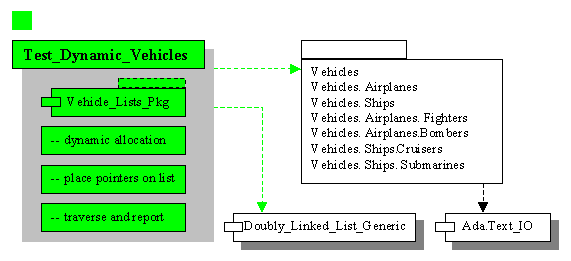----------------------------------------------------------
-- This procedure tests the derivation class rooted at Vehicle
-- by dynamically allocating 12 vehicles, putting some of the
-- corresponding access values on a linked list, traversing the
-- list to report on positions, and then deploying a few
-- weapons.
----------------------------------------------------------
with Vehicles, Vehicles.Airplanes, Vehicles.Ships;
use Vehicles, Vehicles.Airplanes, Vehicles.Ships;
with Vehicles.Airplanes.Fighters, Vehicles.Airplanes.Bombers;
use Vehicles.Airplanes.Fighters, Vehicles.Airplanes.Bombers;
with Vehicles.Ships.Cruisers, Vehicles.Ships.Submarines;
use Vehicles.Ships.Cruisers, Vehicles.Ships.Submarines;
with Doubly_Linked_Lists_Generic;
procedure Test_Dynamic_Vehicles is
type Vptr_Type is access all Vehicle'Class;
VP : array (1..100) of Vptr_Type; -- ample supply of pointers
VPX : Vptr_Type;
package Vehicle_Lists_Pkg is -- generic instantiation
new Doubly_Linked_Lists_Generic(Vptr_Type);
use Vehicle_Lists_Pkg;
Vehicle_List : List; -- create list
Current : Position; -- create pointer
begin
-- dynamic allocation of 12 Vehicles
for I in 1..3 loop
VP(I) := new Fighter;
end loop;
for I in 4..6 loop
VP(I) := new Bomber;
end loop;
for I in 7..9 loop
VP(I) := new Cruiser;
end loop;
for I in 10..12 loop
VP(I) := new Submarine;
end loop;
-- initialization of 6 Vehicles
-- (off Cape Canaveral, heading East)
Rename_Reset(VP(1).all, "F1", 30, -75, 90);
Rename_Reset(VP(2).all, "F2", 32, -75, 90);
Rename_Reset(VP(4).all, "B1", 31, -75, 90);
Rename_Reset(VP(7).all, "C1", 30, -77, 90);
Rename_Reset(VP(8).all, "C2", 32, -75, 90);
Rename_Reset(VP(10).all, "S1", 31, -75, 90);
-- place pointers on list
AddToRear(Vehicle_List, VP(1));
AddToRear(Vehicle_List, VP(2));
AddToRear(Vehicle_List, VP(4));
AddToRear(Vehicle_List, VP(7));
AddToRear(Vehicle_List, VP(8));
AddToRear(Vehicle_List, VP(10));
Current := First(Vehicle_List); -- traverse list and
loop -- report positions
VPX := Retrieve(Vehicle_List, Current);
Report_Position(VPX.all);
exit when Is_Last(Vehicle_List, Current);
GoAhead(Vehicle_List, Current);
end loop;
Deploy_Weapon(VP(4).all);
Deploy_Weapon(VP(7).all);
Deploy_Weapon(VP(10).all);
end Test_Dynamic_Vehicles;
----------------------------------------------------------
|
